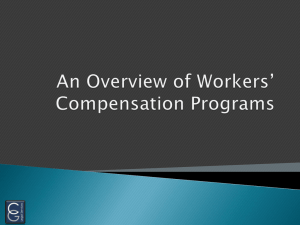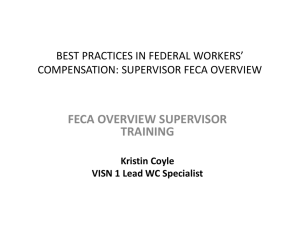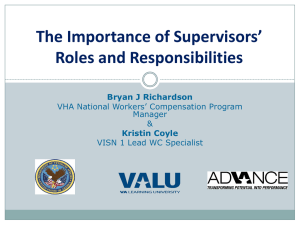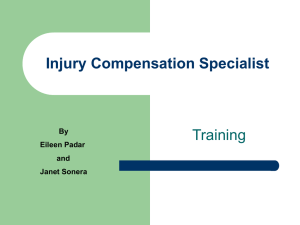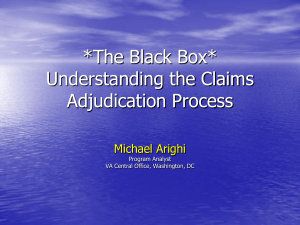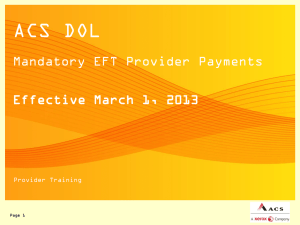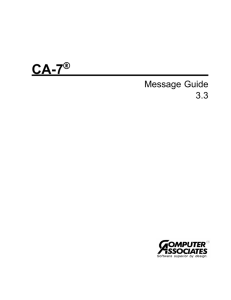Workers` Compensation
advertisement
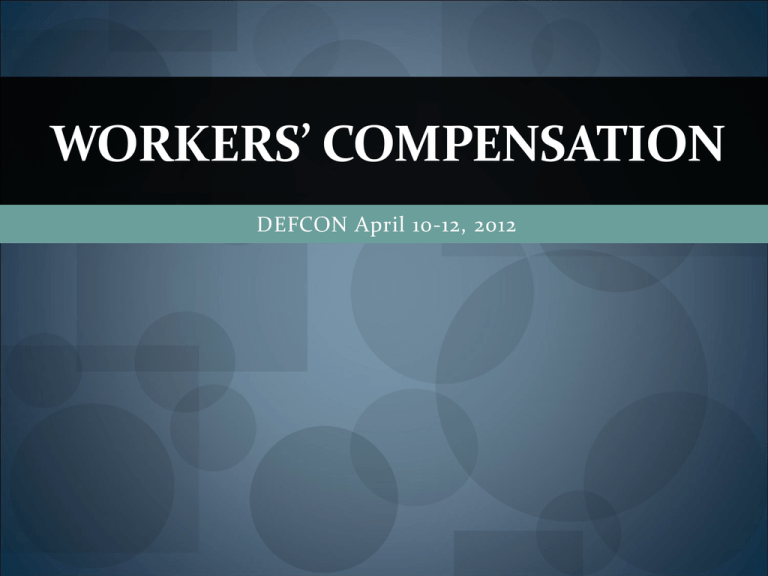
WORKERS’ COMPENSATION DEFCON April 10-12, 2012 Overview Key Terms / Causal Relationships Federal Employees’ Compensation Act (FECA) Provisions of FECA Types of Injuries and Claim Forms Filing a Claim for Compensation Continuation Of Pay (COP) Requirements Internet Resources Key Terms Attending Physician (AP) - The claimant’s AP is the primary source of medical evidence in most cases. That physician usually sees the claimant soon after the injury or the onset of symptoms. He or she may also be familiar with the claimant's medical history and therefore may know of any pre-existing condition which may be responsible for the symptoms, or which may have been aggravated by the incident or employment factor claimed. Causal Relationship – 4 Types: Direct Causation; Aggravation; Acceleration; and Precipitation Controversion. The agency will inform the employee whether COP will be controverted and, if so, whether pay will be terminated, and the basis for such action (the reasons must conform with those indicated in paragraph 9 below). The agency will also explain the basis for controversion (if any) on Form CA1 or by separate narrative report, 20 C.F.R. 10.211(c). Key Terms Continuation Of Pay (COP) - An employee who sustains a disabling job-related traumatic injury is entitled to continuation of regular pay (COP) for a period not to exceed 45 calendar days. To qualify for COP, the injured employee must file written notice of injury and claim for COP within 30 days of the injury. COP is not considered compensation and is subject to taxes and other payroll deductions. The employee must make separate claim for monetary compensation if the disability exceeds 45 days or results in any permanent disability. See FECA PM 2-807. Date of Injury (DOI) - Date that a traumatic injury occurs, the date of death, or the date of last injurious exposure in the case of occupational disease. Employee – Federal or civil employee. Key Terms Fact of Injury - The term "injury" includes both traumatic incidents and occupational illnesses. (1) Whether the claimant actually experienced the accident, untoward event, or employment factor which is alleged to have occurred. This is a factual determination. (2) Whether a medical condition has been diagnosed in connection with this event. To make this determination, medical evidence is required. Leave Buy Back (LBB) - When an employee elects to use sick or annual leave during the period of disability, he or she may later, with the concurrence of the employing agency, claim compensation for the period of disability and "buy back" the leave used (20 C.F.R. § 10.425). Reinstatement of Leave. Key Terms Occupational Disease (OD) or Illness - A condition which is produced by continued or repeated exposure to elements of the work environment such as noxious substances or damaging noise levels over a period longer than one work day or shift; a condition which arises over more than one work day or shift. OD claims are classified as either basic or extended. 20 CFR 10.5(q). OWCP - Office of Workers’ Compensation Program Key Terms Schedule Award - The FECA also provides for payment of compensation for permanent loss or loss of use (either partial or total) of certain internal organs and members or functions of the body such as arms, legs, hands, feet, fingers, toes, eyes, and loss of hearing or loss of vision. Each extremity or function has been rated at a specific number of weeks of compensation which can be paid even though the employee returns to work at full salary. Where a serious disfigurement of the head, face, or neck results from a job-related injury, an award may also be made for such disfigurement, not to exceed $3,500. See FECA PM 2808. Key Terms Prima Facie - [Latin, On the first appearance.] A fact presumed to be true unless it is disproved. Traumatic Injury - A wound or other condition of the body caused by external force, including stress or strain. The injury must be identifiable as to time and place of occurrence and member or function of the body affected. It must be caused by a specific event or incident or series of events or incidents during a single day or work shift. 20 CFR 10.5 (ee). Causal Relationships 1) Direct Causation - This type of relationship is shown when the injury or factors of employment, through a natural and unbroken sequence, result in the condition claimed. A fractured arm sustained in a fall would be considered a direct result of the fall, and a sensorineural hearing loss might likewise be caused directly by occupational noise exposure over a period of time. In occupational disease claims, however, the medical evidence needed to support the relationship will likely require greater rationale than in traumatic injury claims. The phrase "proximately caused" is used also to designate this kind of relationship. Causal Relationships 2)Aggravation - This kind of relationship occurs if a pre-existing condition is worsened, either temporarily or permanently, by an injury arising in the course of employment. For instance, a traumatic back injury may aggravate a claimant's pre-existing degenerative disc disease, and compensation would be payable for the duration of the aggravation as medically determined. Causal Relationships 3)Acceleration - An employment-related injury or illness may hasten the development of an underlying condition, and acceleration is said to occur when the ordinary course of the disease does not account for the speed with which a condition develops. For example, a claimant's diabetes may be accelerated by a work schedule which is so erratic that it prohibits the regular food intake required by persons with this condition. An acceptance for acceleration of a condition carries the same force as an acceptance for direct causation. That is, the condition has been accepted with no limitation on its duration or severity. Causal Relationships 4) Precipitation – A latent condition which would not have become manifest but for the employment is said to have been precipitated by factors of the employment. For instance, tuberculosis may be latent for a number of years, then become manifest due to renewed exposure in the workplace. The claim would be accepted for precipitation, but the acceptance would be limited to the period of work-related tuberculosis and the OWCP's responsibility for the condition would cease once the person recovered. Any ensuing episode of the disease would be considered workrelated only if medical evidence supported such a continued relationship. In this way acceptance for precipitation may resemble acceptance for temporary aggravation. A claim can also be accepted for precipitation of a condition with no limit on the duration of the acceptance. Federal Employees’ Compensation Act FECA was passed in 1916 Administered by Department of Labor, Office of Workers’ Compensation Programs (OWCP) Non-adversarial Exclusive Remedy Provisions of FECA Medical Benefits Continuation of Pay (COP) Wage Loss Compensation Schedule Awards Vocational Rehabilitation Death/Burial Expenses (Section 5 U.S.C. 8134 ) Conditions of Coverage Timely Filing of Claim Federal Civilian Employee Fact of Injury Performance of Duty Causal Relationship A B C Timely Filing Fact of Injury Employee has three years from: Date of Injury Date of First Awareness Date of Last Exposure Two Components Factual Medical Causal Relationship Link between work-related exposure and medical condition being claimed. Four Types: Direct Causation Aggravation Acceleration Precipitation Cause Effect Result Service-Related Medical Conditions How do they impact work-related injuries or illnesses? How does Office of Workers’ Compensation Program (OWCP) treat them? How do we help the member with service-related conditions affected by workplace conditions? Statutory Exclusions Willful Misconduct Drug or Alcohol Intoxication Intent to Injure Self or Others Covered or Not Covered? Scenario 1: A VA nurse is moving a patient and injures her back. She immediately notifies her supervisor. She has no witnesses who saw the injury occur on working hours. Scenario 2: A SSA retiree files a claim for workers’ compensation for an injury that he incurred five years before when working in a warehouse while on duty. Scenario 3: A Coast Guard employee complains of a sprained ankle received when he slipped on a section of ice on the sidewalk outside the office. Types of Injuries and Claim Forms OWCP Most Often Used Forms FORM TITLE USE EMPLOYEE TIMELINE AGENCY TIMELINE CA-1 Federal Employee’s Notice of Traumatic Injury and Claim for Continuation of Pay/Compensation Traumatic injury, occurs within one work shift Within 30 days of injury to get COP; up to 3 years, but should file as soon as possible Submit to OWCP within 10 workdays of receipt from employee CA-2 Notice of Occupational Disease and Claim for Compensation Long-term or chronic illness or disease As soon as employee realizes it’s workrelated Submit to OWCP within 10 workdays of receipt from employee CA-2a Notice of Employee’s Recurrence of Disability and Claim for Pay/Compensation After returning to work, the employee needs to stop work or needs more medical treatment due to the injury As soon as possible Immediately when received from employee CA-7 Claim for Compensation on Account of Traumatic Injury or Occupational Disease Request compensation for wage loss In traumatic injury cases, submit 10 days before the end of COP; for occupational disease cases, as soon as pays stops Give employee form on the 30th day of COP. Due to OWCP on 40th day of COP. Submit to OWCP within 5 days of receipt. OWCP Most Often Used Forms FORM TITLE USE EMPLOYEE TIMELINE AGENCY TIMELINE CA-16 Authorization for Examination and/or Treatment Guaranties payment of medical care after traumatic injury Obtain as soon as possible, within 4 days; Doctor submits after initial exam Within 4 hours of injury CA-17 Duty Status Report Provides information on ability to return to work Get from doctor after exam As soon as exam is done CA-20 Attending Physician’s Report (attached to Form CA-7; also available separately) Provides medical support for claim Get from doctor after initial exam As soon as exam is done CA-35 a-h Occupational Disease Checklists Provides medical support for specific conditions As soon as doctor fills out; submit with CA-2 Within 10 workdays of receipt from employee; submit with CA-2 OWCP 1500a Health Insurance Claim Form Standard billing form Doctor submits; employee signs As soon as exam is done Traumatic Injury Injury caused by specific event or series of events occurring during one work shift. Eligible for Continuation of Pay (COP) / Compensation. Filing a Traumatic Injury Claim CA-1: Notice of Traumatic Injury CA-16: Authorization for Examination Questions for Injury/Injuries (Pg. 1) 1. What federal agency do you work for? 2.Where did the injury/injuries take place? 3. What job related activities were you performing when you were injured? 4.What time did the injury/injuries occur? 5.When did you begin to feel pain or other related symptoms from the accident or injury/injuries? 6.Where did you feel pain, numbness, tingling, or other symptoms of the injury/injuries? Questions for Injury/Injuries (Pg. 2) 7. What parts of your body were involved in the accident (include any part of your body that you may have used to prevent injury/injuries such as using your hands and arms to stop a fall)? 8. Did anyone witness your accident or injury/injuries? If so, what is/are their name(s), work position, and contact information? 9. Have you received medical attention for your injury/injuries? If so, who provided the medical care and when was it provided? 10.When did you notify your supervisor of the injury/injuries? 11.Did you leave work due to your injury/injuries? 12.Did you have to switch job duties due to your injury/injuries? CA-1: Notice of Traumatic Injury Two Parts Employee completes the front; and Supervisor or Human Resources completes the back. Must be transmitted by Human Resources to Office of Workers’ Compensation (OWCP) within 10 workdays from date the Agency receives the form. Employees should complete and send in the form as soon as possible. CA-16: Authorization for Examination/Treatment Issued to employee within four hours of injury. Verbal authorization can be given; issue within 48 hours. Not required after one week. Guarantees payment for all non-invasive procedures and routine treatment or examination for 60 days after traumatic injury. Supervisor completes the front of the form, physician completes the back. Does NOT authorize: exercise equipment, surgery, work hardening, functional capability evaluation (FCE), etc. COP: Basic Requirements Only for Traumatic Injury events. Injury must be reported on CA-1 within 30 days. Prima facie medical evidence must be provided within 10 calendar days from the date of filing. Disability begins within 45 days after injury event (not including the day of injury). Occupational Disease Condition produced over a period longer than one work day or work shift. Examples include repetitive motion disorder, asbestosis, silicosis, etc. Not eligible for Continuation Of Pay (COP). Questions for Workplace Illness or Disease (Pg. 1) 1. What federal agency do you work for? 2.When did you first experience symptoms of the disease/illness? 3. What job duties have you performed/do you perform that are related to the disease/illness? 4.How long have you performed these duties? 5.Do you have anyone witness you perform these duties? If so, what is/are their name(s), work position, and contact information? Questions for Workplace Illness or Disease (Pg. 2) 6.Do you have documentation (job description, material safety data sheets, etc.) which confirms that your work has caused a disease/illness? 7.When did you notify your supervisor of the illness/disease? 8.Did you leave work due to your illness? 9.Did you have to switch job duties due to your illness? 10.Have you received medical attention for your illness/disease? If so, who provided the medical care and when was it provided. Questions for Workplace Illness or Disease (Pg. 3) 11.Do you have any of the following: a. Hearing Loss (Form CA-35b) b. Asbestos-Related Illness (Form CA-35c) c. Coronary/Vascular Condition (Form CA-35d) d.Skin Disease (Form CA-35e) e. Pulmonary Illness that is not Asbestosis (Form CA-35f) f. Psychiatric Illness (Form CA-35g) g. Carpal Tunnel Syndrome (Form CA-35h) Filing a Claim for Occupational Disease CA-2: Notice of Occupational Disease Two parts: Employee completes the front; and Supervisor or HR completes the back. Must be transmitted to OWCP within 10 workdays. CA-35 (a-h): Occupational Disease Checklist Occupational Disease Checklist. Lists information required from both employee and supervisor. Specific forms for seven different conditions and general occupational disease. Filing a Claim for Compensation CA-7: Claim for Compensation CA-17: Duty Status Report CA-20: Attending Physician’s Report CA-7: Claim for Compensation Used for filing wage loss compensation, leave buy back, schedule awards. Agency must send to OWCP within five (5) workdays. Note: Not used for compensation during the 45 days COP period under traumatic injury events. When to file: Wage loss compensation: COP ends; LWOP starts and biweekly afterwards. Leave buy back: within one year of date leave used or claim accepted, whichever is later (CA 7a and CA 7b). Schedule award: maximum medical improvement. CA-20: Attending Physician’s Report Submitted to OWCP along with CA-7 for wage loss or leave buy back. Requests information: Diagnosis Prognosis History of injury Prima facie statement of causal relationships, etc. CA-17: Duty Status Report Provides OWCP and Agency with medical report about the employee’s ability to work. Agency can send to physician at any time during life of claim. Getting through the OWCP Process: Selecting and Completing the Right Forms Occurrence Traumatic Injury Definition Timeline Claim Forms A wound or other condition of the body caused by external force, including stress or strain. It must be identifiable by time and place or occurrence and member of the body affected. Must be caused by specific event or incident or series of events or incidents within a single day or work shift. CA-1 Notice of Traumatic Injury and Claim for Continuation of Pay (Employee/Supervisor/OWCP) •HR sends to OWCP in 10 days. •Must file in 30 days for COP. An approved CA-1 starts the workers compensation claim process. The CA-1 can authorize up to 45 calendar days of regular pay for traumatic injuries only. This pay is referred to as COP (continuation of pay) and begins the day after the reported injury. CA-16 Request for Examination and/or Treatment (Supervisor/Physician) •FECA states that employer shall issue CA-16 within 4 hours of claimed injury. •Typically issued within 48 hours of notice. •If employee does not request treatment for more than 5 days after injury, supervisor may not issue CA-16. The employee’s doctor should complete a CA17 Duty Status Report. This form will provide information on the employee’s ability to work, how long the employee may need to stay away from work and whether the employee can work with some restrictions. Supervisor will promptly authorize medical care upon receiving notice that an employee has sustained a jobrelated traumatic injury. A CA-16 form authorizes the employer to pay for the cost of the medical examination and treatment. CA-7 Claim for Compensation (Employee/Supervisor/OWCP) To be approved, the CA-7 must also include the CA-20 Attending Physician Report. An approved CA-7 will cover the employee’s disability beyond the 45 day COP period. A scheduled award can be provided for loss of function or body part. OWCP HANDOUT: INJURY and ILLNESS Benefit Occurrence Occupational Disease Definition Timeline Claim Forms Benefit Systematic infections, continued or repeated stress or strain, or exposure to toxins, poisonous fumes, noise, etc. in the work environment over a prolonged period of time. In order to qualify as a disease, the injury must be caused by exposure or activities on at least two days. CA-2 Federal Employee’s Notice of Occupational Disease and Claim for Compensation •Employee should file CA-2 within 30 calendar days of employee awareness of a possible connection between the illness or disease and the job. Use CA-35(a-h) to document occupational disease. Once a CA-2 claim is approved, medical expenses related to the accepted illness or disease will be reimbursed. The employee should keep all receipts and statements related to the claim to submit them for reimbursement. Upon approval of CA2, OWCP-1500a or a standard billing form such as HFCA 1500 is used to request reimbursement. Mileage reimbursement is requested on SF 1012. CA-7 Claim for Compensation (Employee/Supervisor/OWCP) To be approved, the CA-7 must also include the CA-20 Attending Physician’s Report. An approved CA-7 will cover the employee’s financial compensation for time lost from work or for a scheduled award. OWCP HANDOUT: INJURY and ILLNESS Occurrence Recurring Traumatic Injury or Occupational Disease Definition Timeline Claim Forms Benefit Spontaneous return or increase of disability without intervening cause, or return or increase of disability due to consequential injury. A recurrence is distinguished from new injury by the fact that no event other than previous injury accounts for the disability. Occurs after the employee has returned to work after being out due to a work-related medical condition. CA-2a Notice of Recurrence Employee should file CA-2a within 30 calendar days of employee awareness of a possible connection between the recurring condition and the job. Once the CA-2a is approved, the employee is entitled to reimbursement of medical expenses related to the injury or illness. In the case of injury, if the 45 day balance of COP has not expired since the return to work, the employee can use the remainder of their initial COP authorization. CA-7 Claim for Compensation (Employee/Supervisor/OWCP) To be approved, the CA-7 must also include the CA-20 Attending Physician’s Report. An approved CA-7 will cover the employee’s financial compensation for time lost from work or for a scheduled award. FECA Regulations 20 CFR Part 10 What information must the physician’s report include? (Pg. 1) Reference: Sec. 10.330 a)Dates of examination and treatment; b)History given by the employee; c)Physical findings; d)Results of diagnostic tests; e)Diagnosis; f) Course of treatment; g)A description of any other conditions found but not due to the claimed injury; What information must the physician’s report include? (Pg. 2) Reference: Sec. 10.330 h)The treatment given or recommended for the claimed injury; i) The physician’s opinion, with medical reasons, as to causal relationship between the diagnosed condition(s) and the factors or conditions of the employment; j) The extent of disability affecting the employee’s ability to work due to the injury; k)The prognosis for recovery; and l) All other material findings. What criminal penalties are included in the FECA regulations? (Pg. 1) Reference: Sec. 10.16 a)A number of statutory provisions make it a crime to file a false or fraudulent claim or statement with the Government in connection with a claim under the FECA, or to wrongfully impede a FECA claim. Included among these provisions are sections 287, 1001, 1920, and 1922 of title 18, United States Code. Enforcement of these and other criminal provisions that may apply to claims under the FECA are within the jurisdiction of the Department of Justice. What criminal penalties are included in the FECA regulations? (Pg. 2) Reference: Sec. 10.16 b)In addition, administrative proceedings may be initiated under the Program Fraud Civil Remedies Act of 1986 (PFCRA), 31 USC 3801-12, to impose civil penalties and assessments against persons who make, submit, or present, or cause to be made, submitted or presented, false fictitious or fraudulent claims or written statements to OWCP in connection with a claim under the FECA. The Department of Labor’s regulations implementing the PFRCA are found at 29 CFR part 22. What are the 3 types of appeals? (Pg. 1) Reference: Subpart G—Appeals Process 1) Reconsiderations and Reviews by the Director a. An application for reconsideration must be sent within one year of the date of the OWCP decision for which review is sought. b. When application for reconsideration is granted, OWCP will review the decision for which reconsideration is sought on the merits and determine whether the new evidence or argument requires modification of the prior decision. What are the 3 types of appeals? (Pg. 2) Reference: Subpart G—Appeals Process 2)Hearings a. The hearing request must be sent within 30 days (as determined by postmark or other carrier’s date marking) of the date of the decision for which a hearing is sought. b. The claimant should submit, with his/her application for review, all evidence or argument that he/she wants to present to the hearing representative. A copy of all pertinent material will be sent to the employer, which will have 20 days from the date it is sent to comment. Medical evidence is not considered “pertinent.” What are the 3 types of appeals? (Pg. 3) Reference: Subpart G—Appeals Process c. A claimant may request a subpoena, but the decision to grant or deny such a request is within the discretion of the hearing representative. d. Where OWCP asked that the witness submit evidence into the case record or asked that the witness attend, OWCP shall pay the fees and mileage. Where the claimant requested the subpoena, and where the witness submitted evidence into the record at the request of the claimant, the claimant shall pay the fees and mileage. e. The claimant and/or representative may withdraw the hearing request at any time up to and including the day the hearing is held, or the decision issued. What are the 3 types of appeals? (Pg. 3) Reference: Subpart G—Appeals Process 3)Review by the Employees’ Compensation Appeals Board (ECAB) a. Only final decisions of OWCP may be appealed to the ECAB, with the following exceptions: 1. Decisions concerning amounts payable for medical services; 2. Decisions concerning exclusion and reinstatement of medical providers; 3. Decisions by the Director to review an award on his/her own motion; 4. Denials of subpoenas independent of the appeal of the underlying decision b. OWCP has no jurisdiction over the claim with respect to issues which directly relate to the issue(s) on appeal. Under what circumstances can an agency stop paying COP? (Pg. 1) Reference: Sec. 10.222 a)Medical evidence which on its face supports disability due to a work-related injury is not received within 10 calendar days after the claim is submitted (unless the employer’s own investigation shows disability to exist). Where the medical evidence is later provided, however, COP shall be reinstated retroactive to the date of termination; b)The medical evidence from the treating physician shows that the employee is not disabled from his/her regular position; Under what circumstances can an agency stop paying COP? (Pg. 2) Reference: Sec. 10.222 c)Medical evidence from the treating physician shows that the employee is not totally disabled, and the employee refuses a written offer of a suitable alternative position which is approved by the attending physician. If OWCP later determines that the position was not suitable, OWCP will direct the employer to grant the employee COP retroactive to the termination date; d)The employee returns to work with no loss of pay; Under what circumstances can an agency stop paying COP? (Pg. 3) Reference: Sec. 10.222 e)The employee’s period of employment expires or employment is otherwise terminated (as established prior to the date of injury); f) OWCP directs the employer to stop COP; and/or g)COP has been paid for 45 calendar days. What happens when the OWCP doctor disagrees with your doctor? (Pg. 1) Reference: Sec. 10.321 a)If one medical opinion holds more probative value, OWCP will base its determination of entitlement on that medical conclusion (see Sec. 10.502). A difference in medical opinion sufficient to be considered a conflict occurs when two reports of virtually equal weight and rationale reach opposing conclusions (see James P. Roberts, 31 ECAB 1010 (1980)). What happens when the OWCP doctor disagrees with your doctor? (Pg. 2) Reference: Sec. 10.321 b) If a conflict exists between the medical opinion of the employee’s physician and the medical opinion of either a second opinion physician or an OWCP medical adviser or consultant, OWCP shall appoint a third physician to make an examination (see Sec. 10.502). This is called a referee examination. OWCP will select a physician who is qualified in the appropriate specialty and who has had no prior connection with the case. The employee is not entitled to have anyone present at the examination unless OWCP decides that exceptional circumstances exist. For example, where a hearing-impaired employee needs an interpreter, the presence of an interpreter would be allowed. Also, a case file may be sent for referee medical review where there is no need for an actual examination, or where the employee is deceased. Your Rights under FECA (Pg. 1) True or False 1) The supervisor decides if it is appropriate to file a claim for benefits under FECA. 2) The claimant’s representative cannot be a federal employee. 3) The representative receives copies from OWCP of all notices to claimant, determinations or decisions and requests for evidence. 4) Continuation of pay can be delayed or stopped by the agency when the agency receives repudiating statements of the injury from co-workers. 5) In an oral hearing the employee, his/her representative, and the agency can provide testimony to support their opinion of the claim. 6) The agency may not interfere with the employee’s choice of physician. 7) The FECA is the exclusive remedy against the United States for employment- related injuries or deaths. Your Rights under FECA (Pg. 2) True or False 8) Form CA-17 is important in that it is completed by the supervisor and the physician and provides information as to employee’s ability to return to any type of work. 9) An injured employee cannot file directly with OWCP; the claim has to go through the agency. 10) The employer authorizes medical treatment using Form CA-16 for both injuries and illnesses. 11) An employee has to use sick or annual leave before compensation can start. 12) Form CA-2b is also used to report an inability to work because a limited duty position has been withdrawn or the physical demands of that position exceed the employee’s medical restrictions. 13) An employee who recovers within one year of going out on compensation has the right to return to the old position or a similar one. 14) The agency can decide, based on the medical evidence, when an employee can return to work. Exercise # 1-3 Case Studies – Initial Report 1. Bob McDonald – DOD Employee: Fell down and hurt myself while walking to a meeting to go to the doctor. 2. Sallie Atwood – USDA Food Inspector: I have problems using my right hand as I have numbness in my fingers. Doctor thinks that it is related to my job inspecting poultry for the USDA. 3. Tim Button – TSA Baggage Inspector: I was seriously hurt in an accident while unloading bags at Gate C. Have not returned to work. Exercise # 4-6 Case Studies – Initial Report 4.Alonso Ramirez – Border Patrol Agent: Involved in a collision with my service vehicle near Modesto Gomez Park. Taken for medical treatment due to injuries. 5. Wendy Malone – Bureau of Prisons Guard: Removed from active duty because of an infected arm caused by an earlier work-related injury. Need follow-up medical treatment. 6.Tina Washington – VA Nurse: Oxygen gas canister fell on my foot, had to see the agency doctor. Questions Is it covered under FECA? Is it an Injury or an Illness? What forms apply? What specific timeline or deadlines may affect processing this claim? Case Study “A worker in your unit, Tom Benigan runs up to you as you are ending your shift. He tells you that Maria cut herself in the office while opening some materials that had been sent from headquarters. You go with Tom to see Maria, who is in pain and some embarrassment. She was cut with the box cutter she was using. She has managed to stop the bleeding in her leg with a rag.” What actions should be taken in this situation? Workers’ Compensation Training Resource List www.dol.gov – Department of Labor (DOL) http://www.dol.gov/owcp/dfec/ - Division of Federal Employees’ Compensation (DFEC) http://www.ecomp.us/ - Employee compensation operations and management portal. An employee can sign in and review their own case. http://owcp.dol.acs-inc.com/portal/main.do - ACS Web Bill Processing Portal; search for FECA medical provider Workers’ Compensation Training AFGE POC AFGE Contact: Milly Rodriguez Email: rodrim@afge.org Phone: (202) 639-4136 Call after you have tried to research question.
